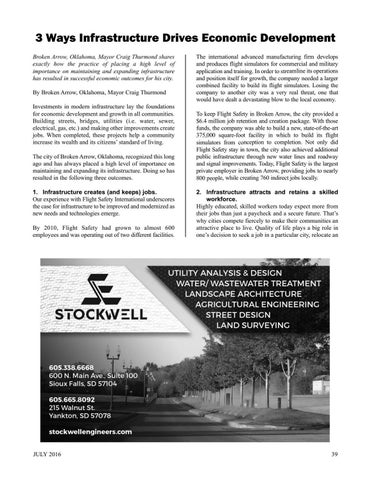3 Ways Infrastructure Drives Economic Development Broken Arrow, Oklahoma, Mayor Craig Thurmond shares exactly how the practice of placing a high level of importance on maintaining and expanding infrastructure has resulted in successful economic outcomes for his city. By Broken Arrow, Oklahoma, Mayor Craig Thurmond Investments in modern infrastructure lay the foundations for economic development and growth in all communities. Building streets, bridges, utilities (i.e. water, sewer, electrical, gas, etc.) and making other improvements create jobs. When completed, these projects help a community increase its wealth and its citizens’ standard of living. The city of Broken Arrow, Oklahoma, recognized this long ago and has always placed a high level of importance on maintaining and expanding its infrastructure. Doing so has resulted in the following three outcomes. 1. Infrastructure creates (and keeps) jobs. Our experience with Flight Safety International underscores the case for infrastructure to be improved and modernized as new needs and technologies emerge. By 2010, Flight Safety had grown to almost 600 employees and was operating out of two different facilities.
JULY 2016
The international advanced manufacturing firm develops and produces flight simulators for commercial and military application and training. In order to streamline its operations and position itself for growth, the company needed a larger combined facility to build its flight simulators. Losing the company to another city was a very real threat, one that would have dealt a devastating blow to the local economy. To keep Flight Safety in Broken Arrow, the city provided a $6.4 million job retention and creation package. With those funds, the company was able to build a new, state-of-the-art 375,000 square-foot facility in which to build its flight simulators from conception to completion. Not only did Flight Safety stay in town, the city also achieved additional public infrastructure through new water lines and roadway and signal improvements. Today, Flight Safety is the largest private employer in Broken Arrow, providing jobs to nearly 800 people, while creating 760 indirect jobs locally. 2. Infrastructure attracts and retains a skilled workforce. Highly educated, skilled workers today expect more from their jobs than just a paycheck and a secure future. That’s why cities compete fiercely to make their communities an attractive place to live. Quality of life plays a big role in one’s decision to seek a job in a particular city, relocate an
39

















